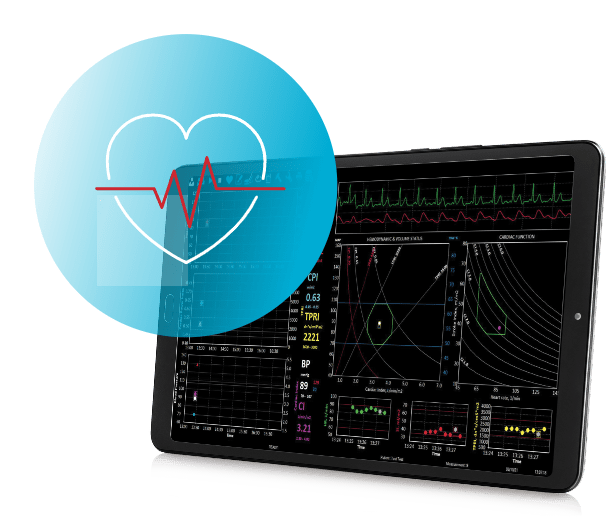Heart Failure
NICaS is designed to help health providers to improve patient’s care and lower heart failure readmission rates, by providing caretakers with accurate information on patient hemodynamic status, allowing them to personalize the treatment and titrate medication if needed.
Challenges
Determining the different causes of acute or chronic hemodynamic instability.
Over-or under-prescribing diuretics for the HF patient.
Viewing trends in hemodynamic status throughout the patient’s treatment period in the community setting or in the hospital.
Solutions
Trends in a hemodynamic profile are viewed on a specially designed screen that is easy to understand.
Decisions on which medication to administer are facilitated.
Our clients report a 95% decrease in readmission.
Heart Failure In Numbers:
6.5M – Approximately 6.5 million adults in the United States are diagnosed with heart failure each year.
1 IN 8 People – Heart failure was a contributing cause of 1 in every 8 deaths in 2020.
$30.7B – Heart failure costs the U.S. an estimated $30.7 billion annually.

Readmission & Hospitalization Reduction
Heart failure is responsible for 11 million physician visits each year and leads to more hospitalizations than all forms of cancer combined.
NICaS can help reduce hospitalization and readmission rates. This technology can assist in the assessment and management of CHF patients in various settings.
Related Clinical Markets
Related Clinical Studies
The Impact of Positive Inotropic Therapy on Hemodynamics and Organ Function in Acute Heart Failure: A Differentiated View
Authors: Juan Cheko, Nikolaos Patsalis, Julian Kreutz, Dimitar Divchev, Georgios Chatzis, Bernhard Schieffer, Birgit Markus Conclusion: Patients with acute decompensated HF benefit from positive inotropic
Comparing elective and emergency caesarean section by using bioimpedance method
Authors: Zuhal Çavuş, Ayşe Vahapoğlu, Ülkü Aygen Türkmen, Fatma Ketenci Gencer, Elif Yıldız Conclusion: Understanding normal hemodynamic values before, during, and after C/S is feasible
Noninvasive Hemodynamic Evaluation Following TAVI for Severe Aortic Stenosis
Authors: Tzlil Grinberg, Yaron Aviv, Mordehay Vaturi, Leor Perl, Maya Wiessman, Hanna Vaknin-Assa, Pablo Codner, Yaron Shapira, Ran Kornowski, Katia Orvin Conclusion: Unique short‐term adaptive
Correlation of Impedance Cardiography-Derived and Cardiac Magnetic Resonance-Derived Stroke Volumes
Authors: Pedram Hassan-Tash, Umar Ismail, Iain D C Kirkpatrick, Amir Ravandi, Davinder S Jassal, Brett Hiebert, Malek Kass, Richard A Krasuski, Ashish H Shah Conclusion:
Non-invasive hemodynamic evaluation following TAVI for severe aortic stenosis
Authors: K Orvin, T Grinberg, R Kornowski, Maya Wiessman, Yaron Aviv, Leor Perl CONCLUSION: A unique pattern of short and longer-term adaptive hemodynamic changes was
Lack of Concordance Between Parameters Defining Cardiogenic Shock in Patients With ST Elevation Myocardial Infarction
Authors: Triston Eastman, Mirna Ragheb, Mullein Thorleifson, Brett Hiebert, Kunal Minhas, Malek Kass, Amir Ravandi and Ashish Shah Conclusion: Our study is the first to
Non-Invasive Hemodynamic Whole-Body Bioimpedance Indices for the Early Detection of Cancer Treatment-Related Cardiotoxicity: A Retrospective Observational Study
Authors: Nili Schamroth Pravda, Shaul Lev , Osnat Itzhaki Ben Zadok, Ran Kornowski, Zaza Iakobishvili Conclusion: GGI, a parameter measured by WBI, can reliably correlate
Accurate noninvasive continuous monitoring of cardiac output by whole body electrical bioimpedance
Authors: Gad Cotter , Yaron Moshkovitz, Edo Kaluski, Amram J Cohen, Hilton Miller, Daniel Goor, Zvi Vered The results of the study indicate that the
The Clinical Research of NICaS for Monitoring Changes of Cardiac Function in Patients with Sepsis (part 2)
Authors: Zhu Yan Second Military Medical University CONCLUSION: (1) In patients with sepsis thrombocytopenia, a high SOFA score indicates that the patient is in critical
